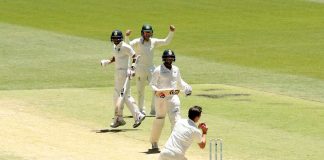MARCH 10, 2019
BRIEF SCORECARD: Australia 359 for 6 (Handscomb 117, Khawaja 91, Turner 84*) beat India 358 for 9 (Dhawan 143, Rohit 93, Cummins 5-70) by 4 wickets

CHANDIGARH – Indian crowds usually tell a story. Between stunned silence at every big shot from Australian bats and booing of their own, Rishabh Pant, for a missed stumping, they narrated a tale of everything gone wrong: of their first failure to defend a total of 350 or more, and that too with 12 balls to spare. It was almost like spoilt wine had been served in the middle of a party. Shikhar Dhawan announced return to form with his personal best, a delightful 143, Rohit Sharma was there with him for a 193-run stand, they managed to reach 358, but once the dew set in – and you should expect it in north India – their bowlers and fielders lost the plot.
Australia found new heroes to go with the old: Pat Cummins’ five-for reduced what looked like 380 to 358, Usman Khawaja followed up his Ranchi century with a 91, Peter Handscomb registered his maiden ODI hundred, but most stunningly of all, Ashton Turner, who probably wouldn’t have played if Marcus Stoinis hadn’t injured his hand, shocked India with an unbeaten 84 off 43 balls. Just get a hang of it: Australia lost captain Aaron Finch for a second-ball duck, they were soon reduced to 12 for 2, the asking rate crossed eight an over in the 13th over, 8.5 in the 26th, 9 in the 29th and 10 in the 43rd. The intent of the 192-run stand between Handscomb and Khawaja was questioned as the asking rate soared, but Turner and dew changed the equation completely.
Virat Kohli’s tactics will be questioned once again. He had two options as Australia began to stich a partnership from 12 for 2. Go for the kill with your strike bowlers or wait for a wicket to fall and then unleash your wicket-takers. Both plans have merit: you can get the part-timers out of the way and then give the main bowlers the tough job or you can try to strike early when the ball is dry. Kohli usually prefers the former – as is shown in how he keeps his best bowler for the last over, often not even needing it – and he did the same here.
Courtesy/Source: ESPNCricinfo










































































































